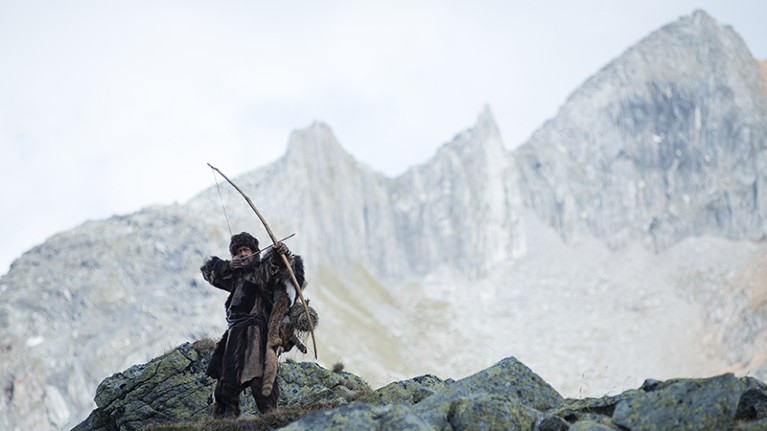
The film imagines Ötzi setting out on a fatal mission to avenge the slaughter of his relatives. Credit: Beta Cinema
Der Mann aus dem Eis (Iceman) Director: F. Randau Port Au Prince Film & Kultur Produktion: 2018.
Huddled in a gloomy cave, a small group of people wearing hides, their hair bedraggled, mourn a woman who has died in childbirth. “Pitamei, Pitamos,” intones Kelab, a bearded, weather-beaten elder, sprinkling herbs over the body. “Bala,” the group responds, as Kelab’s partner Kisis clasps the dead woman’s bundled baby.
That funeral is one of many moments of tenderness in Der Mann aus dem Eis (Iceman). This extraordinary film imagines the life of Ötzi (renamed Kelab), the man whose frozen, mummified, 5,300-year-old corpse was found in 1991 in a mountain pass in the Ötztal Alps, a range that runs along the border between Austria and Italy. All was not altruistic in this world, however, as Berlin-based film-maker Felix Randau emphasizes. In 2001, researchers revealed that Ötzi had been killed when the subclavian artery in his left shoulder was severed by an arrow; and the film features many scenes of horrific violence. The visceral mix of contrasting behaviours humanizes the protagonists. Randau’s feat is to put flesh and blood and feelings into this ancient, frozen human, recreating a society and even a language that are long gone.
Iceman takes us into the stunning beauty of the South Tyrol a few kilometres from where Ötzi was found. His refrigerated mummy is now preserved in the South Tyrol Museum of Archaeology in Bolzano, Italy. For more than two decades, scientists have analysed Ötzi’s bones, teeth, blood, DNA, stomach contents, intestinal parasites, clothing, shoes, tools and tattoos.
They know his height and weight, that he lived during the Copper Age in the late Neolithic era, owned a valuable copper axe, and was about 45 when he was murdered. In addition to his fatal arrow injury, and a severe head injury that might indicate a fall, he had a deep, unhealed cut on one hand; this suggests that shortly before his death, he fended off an attacker who was wielding an axe or knife.
The film sticks closely to archaeological details. Kelab (Jürgen Vogel) lives in a hamlet with Kisis (Susanne Wüst) and other members of his clan, who tend domesticated pigs and goats. He wears a bearskin cap and goat-leather leggings. In the tranquillity of early summer, three marauders suddenly appear.
They rape and kill Kisis, slaughter the rest of the inhabitants and burn the village, stealing, as they leave, the group’s sacred totem (a mirror in a wooden box). Kelab returns from hunting to find carnage. Grief-stricken, he conducts funeral rites for Kisis and goes away, leading a goat, bent on revenge and carrying his orphaned baby in a makeshift sling.
The film’s minimal dialogue is conducted in reconstructed Rhaetic, a language spoken in the eastern Alps in pre-Roman and Roman times. But it’s the action — and Vogel’s wonderfully expressive face — that moves the story along. In pursuit of the marauders, he climbs snow-covered mountainsides in hay-stuffed shoes, and feeds the baby direct from the goat’s teat. He later leaves the child with a young woman and her aged father.
In its portrayal of women, however, the movie presents only a narrow picture of the known archaeological record. Women are mostly shown engaging in child-rearing and sex. Recent research suggests that Neolithic women were athletic and versatile, grinding grain and processing milk, meat, hides and wool.
One study, led by Alison Macintosh at the University of Cambridge (A. Macintosh et al. Sci. Adv. 3, eaao3893; 2017), looked at the skeletal remains of women in Central Europe from about 5,300bc to ad850. The researchers found that the arm bones of the Neolithic women were 11–16% stronger for their size than those of top female rowers today. But the film’s depiction of rape as a weapon of war remains tragically resonant.
Writing about Ötzi for Discover magazine in early 2002, I developed an affinity for this messenger from a distant time. As I watched him in the film, dying in the deep snow, I felt a twinge of sadness. Pitamei, Pitamos, I wanted to say. Bala.

 Anthropology: The Iceman defrosted
Anthropology: The Iceman defrosted
 Archaeology: A distant mirror
Archaeology: A distant mirror
 Q&A: Illuminating the dark
Q&A: Illuminating the dark








